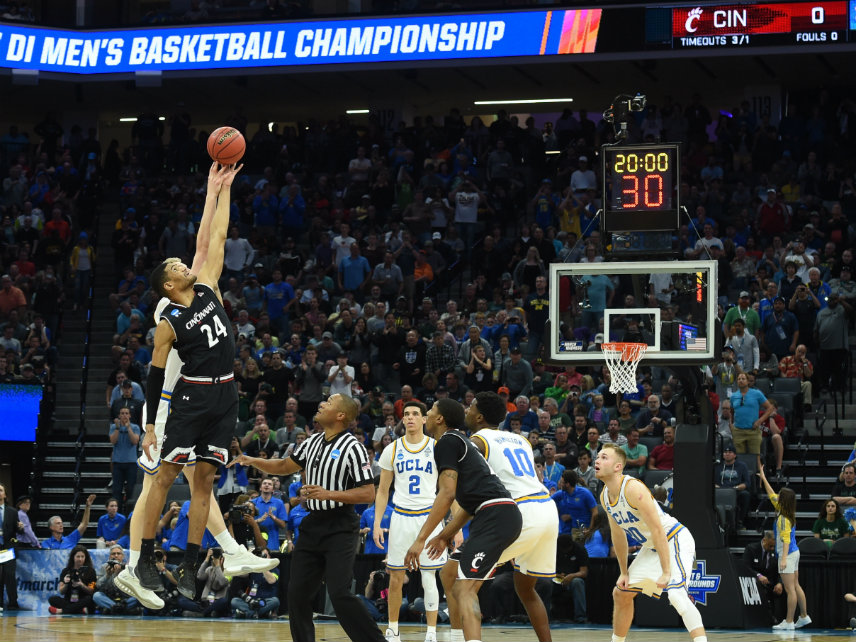Cincinnati Might Spend $300 Million for a Shot at Hosting Six NCAA Tournament Games
The NCAA says Cincinnati will get to host first and second round games in 2022, but only if taxpayers fund massive upgrades to U.S. Bank Arena.

The first weekend of the annual NCAA college basketball tournament is priceless for fans of the sport. The smorgasbord of college hoops includes 48 games played over four days in eight different locations.
When the 2022 tournament comes around, Cincinnati, Ohio, is hoping to be part of the madness. The NCAA has named the city's U.S. Bank Arena as one of the eight hosts for the first two rounds of games that year, but the promise comes with some seriously expensive strings attached. To land just six games, the city will have to fund a $370 million renovation of the 43-year old stadium—and the arena's owners are asking taxpayers to cover $300 million of that total.
Voters in Cincinnati may get a chance to vote on the proposal this November. While city officials have not yet decided what to do with the arena, the Cincinnati Enquirer reports that the most likely funding mechanism would be an extension of an existing "temporary" sales tax that was supposed to expire in 2020. The quarter-cent sales tax is currently being used to fund renovations to Union Terminal, a former passenger rail station now being converted into a museum.
Backers of the proposal are touting a study from the University of Cincinnati claiming that a refurbished arena could be worth $670 million in future economic growth—but stadiums are generally bad public investments and those promises of economic development rarely pay off. The Enquirer says an upgraded facility could help Cincinnati attract political conventions (city leaders are apparently jealous that Cleveland got chosen over Cincy for the 2016 Republican National Convention), big ticket musical acts, and other high profile events.
Still, the best reason to be skeptical of Cincinnati's plans to blow $300 million on an upgraded basketball arena is the city's own history with stadium deals.
Hamilton County, which surrounds and encompasses Cincinnati, spent $350 million (Harvard economist Judith Grant Long estimates the final cost was closer to $550 million, including infrastructure work and cost overruns) in the mid-90s to build a new stadium for the Cincinnati Bengals of the National Football League. The infamously bad deal included a rider putting regional taxpayers on the hook for future upgrades to the stadium. As the Wall Street Journal reported in 2011, Hamilton County "agreed to pick up nearly all operating and capital improvement costs—and to foot the bill for high-tech bells and whistles that have yet to be invented, like a 'holographic replay machine.' No team had snared such concessions in addition to huge sums of public money."
To fund the stadium, Hamilton County took on more than $1 billion in debt. Paying off that debt now consumes about 15 percent of the county's operating budget ever year, according to the Journal, and local officials have been forced to cut funding for schools and the county sheriff's office in order to pay for it. There's plenty of competition, but Cincinnati's stadium deal has been widely labeled the worst such scheme in the country.
A key part of the bad deal, says Roger Noll, a professor of economics at Stanford University, is the "optimistic forecasting" that led local officials to believe the stadium would pay for itself in the long run. Sound familiar?
More recently, Cincinnati has been negotiating with the the modestly successful local professional soccer team, FC Cincinnati, for a new stadium. The team wants to jump from a minor league to Major League Soccer, but MLS has made it clear taxpayers must first agree to fund a new soccer-only stadium for FC Cincinnati, which currently shares facilities with the University of Cincinnati. The price tag: about $200 million, at least half of it coming from public sources, the Cincinnati Business Courier reports.
Letting taxpayers vote on whether to fund a $300 million upgrade to U.S. Bank Arena is the right thing to do—as opposed to just steaming ahead without getting consent from those who will have to pay the tab.
But, really, Cincinnati officials should look at their own history of getting swindled by sports franchises and organizations before even considering asking for the public's input. The NCAA tournament is one of the best sporting events of the year, but's not worth $300 million.




Show Comments (77)